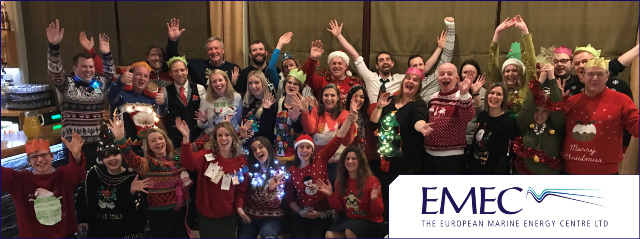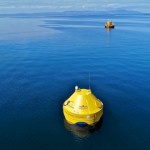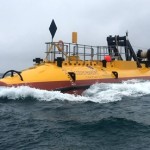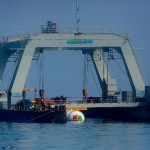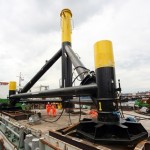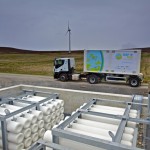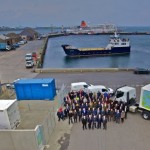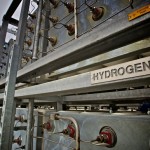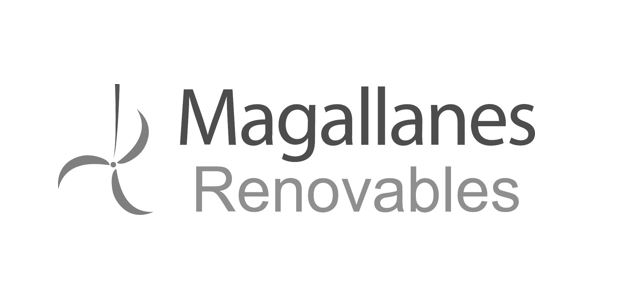Blog: EMEC 2018 Highlights
It’s happening!
2018 has been an exciting year for us.
We’ve seen the viability of tidal energy proven with GWh’s of generation, continued demonstration of the survivability of wave energy, and we continue to diversify having overseen Microsoft’s underwater data centre deployed at our wave test site, and have launched some major hydrogen related projects.
Our staff were keen to tell you about their highlights throughout the year in the video below. Read on for the full review.
Ocean energy demonstration in Orkney
Since we were established, we have hosted 20 wave and tidal energy clients, spanning 11 countries, with 31 marine energy devices. That’s more ocean energy deployments than at any other site in the world!
Bumping up this stat early in the year was CorPower Ocean with the deployment of their C3 wave energy converter (WEC) at EMEC’s Scapa Flow scale test site. CorPower completed their Stage 3 demonstration programme over the summer, with EMEC overseeing the dry and wet testing of the machine, ensuring strict quality management and quality assurance of the verification process and providing Performance Statements for both stages. EMEC continue to work with CorPower to incorporate the learning from these tests into the development of their next generation WEC technology via the WaveBoost project.
Over on our Billia Croo wave energy test site, Wello Oy’s Penguin WEC has safely remained on site since installation in March 2017, having survived several storms and waves of over 18 meters proving the survivability of the technology. As part of the H2020 CEFOW project, Wello launched the next iteration of their Penguin WEC into the water in Tallinn, Estonia earlier this month, which is due to be towed to EMEC next year to be deployed alongside the existing Penguin.
We welcomed Magallanes Renovables back to Orkney in September, having tested a previous iteration of their technology here back in 2014. Final commission of their 2 MW floating tidal energy platform and site preparations are underway and we look forward to seeing the ATIR deployed at the Fall of Warness site as part of the Horizon2020 funded OCEAN_2G project in the new year.
Unfortunately, this year we bid farewell to our longest standing client, OpenHydro, who went into administration in July, a stark reminder of the vulnerability of the industry. Their Open-Centre Turbine has become an iconic representation of renewables in the UK and its contribution to the development of tidal energy will leave a lasting legacy.
Tidal energy powers over 800 homes
A significant highlight for tidal energy this year was watching Orbital Marine Power (previously Scotrenewables) hit the 3 GWh generation milestone in just 12 months of testing. During this time the SR2000 was supplying the equivalent annual electricity demand of around 830 UK households, and at times supplied over 25% of Orkney’s electricity demand.
The SR2000 has now been removed from the site to make way for an optimised production model. We supported Orbital in the Orbital O2 design launch with a stunning 3D animation as part of the H2020 FloTEC project, and look forward to seeing the Orbital O2 deployed at EMEC in 2020.
Touch down for Microsoft data centre: powered by renewables and cooled by the sea
Another highlight of the year was the deployment of Microsoft’s 450 kW underwater data centre at EMEC’s Billia Croo wave energy test site in June (announced by the BBC). Led by Naval Group, the data centre was installed by Green Marine, and is as powerful as several thousand high end consumer PCs, enough storage for approximately five million movies.
The project is part of Microsoft’s ongoing quest for cloud data centre solutions that are less resource intensive and offer rapid provisioning, lower costs, and high agility to meet the needs of cloud users around the world. Deepwater deployment offers ready access to cooling, a controlled environment, and has the potential to be powered by co-located renewable power sources.
The data centre could remain at EMEC for up to five years, and we’re very excited to be involved in such a globally significant project that will shape the future of data storage.
Why is this happening in Orkney? Find out here: Data centres – why Orkney?
Supporting real-sea demonstration
EMEC are involved in various EU funded projects supporting technology developers in accessing and testing at Europe’s range of marine energy centres.
- Marine Energy Alliance (MEA): The first call for applications for MEA opened on 17th December 2018. The project is aiming to progress the technical and commercial maturity level of early-stage (TRL 3-4) marine energy technology companies with the overall goal of reducing the risk of device failure in subsequent demonstration phases. Successful applicants will receive a tailored suite of expert services to support technical advancements as well as the development of commercial strategy and business plans.
- MaRINET2: The second call for MaRINET2 closed in April with Flemish wave developer Laminaria one of the successful applicants receiving support to test at EMEC. The third call closed in December, and we eagerly await the results to see which developers will be coming to test with us through the programme. The project supports transnational companies, developing systems and components for the offshore energy sector, including wind, wave and tidal energy technologies.
- FORESEA: This year we saw CorPower Ocean, Orbital Marine Power, Naval Group and Whitford take advantage of the programme at EMEC, with Laminaria gearing up to deploy at EMEC’s Billia Croo wave test site next year with support from FORESEA (and MaRINET2). FORESEA is proving a real boost to developers, by reducing the cost of accessing world-leading test facilities and helping to attract further investment (see Orbital Marine Power investment press release). The programme also saw the launch of a collaborative decommissioning project led by Blackfish which will conduct forensic analysis of a tidal energy tripod at EMEC’s tidal test site, and feedback lessons learnt to benefit the ocean energy sector. The project also launched a new publication, “Ocean Energy and the Regions: a partnership for growth”, confirming the establishment of clusters of ocean energy and supply chain companies around EU test centres and showcasing the technologies that have been supported through the programme. Having ran four calls to date to provide access to real sea testing, the FORESEA team are preparing for their fifth and final call, set to open in early January 2019.
- Blue-GIFT: Building on the skills, processes and expertise developed in the FORESEA programme, Blue-GIFT was launched in October to drive forward the marine energy sector in the Atlantic Arc. Led by EMEC, FORESEA partners SmartBay and SEM-REV will be working with BiMEP, PLOCAN, SEENEOH, and WavEC to implement a coordinated ocean energy technology demonstration programme that encourages longer term demonstration and technology de-risking across the Atlantic Arc regions.
- ProtoAtlantic: Aimed at developing and validating a model for prototyping and exploitation of innovative ideas in the maritime sector in the Atlantic Area, the ProtoAtlantic project is opening a call to support fast-tracked product development providing the opportunity to test and validate technologies at world renowned tank and open-sea test facilities. Applications for the Fast-Tracked Product Development Programme opens on the 7th January 2019.
Collaboration: research, development and innovation
EMEC are well renowned for our wave and tidal test and demonstration facilities, however we are also involved in an increasing number of RD&I projects aimed to support and develop the marine renewable industry. As well as device development and testing, a lot of work has taken place this year to progress wider innovation, learning and knowledge sharing throughout the industry.
Here are some of the challenges we’re working on:
- Environmental monitoring: We’re leading an exciting new project called SEA Wave (Strategic Environmental Assessment of Wave energy technologies) aiming to provide a deeper understanding about the response of host environments to the presence of WECs. SEA Wave will build on the bespoke environmental research campaigns undertaken in the Horizon 2020 Clean Energy from Ocean Waves (CEFOW) project on Wello Oy’s Penguin WEC, and incorporate future environmental monitoring campaigns on WECs demonstrated by CorPower Ocean, Laminaria and Ocean Energy over the coming three years.
- Biofouling: Earlier in the year we joined forces with the International Centre of Island Technology (ICIT) for the BioFREE project to research practical strategies to minimise the impacts of biofouling for the marine renewable energy industry. The first data collection campaign has been completed with biofouling frames having been deployed at EMEC throughout the year. And we’ve just announced another biofouling project – CleanWinTur – to research solutions to minimise the impacts of biofouling on offshore wind turbines.
- Corrosion: We continue to work with Whitford who have been testing with us for the past four years to analyse existing and developmental coating products to assess their suitability for applications within the marine renewables industry. We’re also involved in the NeSSIE project which we’re reaching out to innovative supply chain companies in the offshore sector to develop commercial solutions for corrosion and material challenges for marine energy converters, subsystems and connectors.
- Moorings: The STORM (Specialised Thimbles for Offshore Renewable Marine energy) project came to a close this year having designed and tested a novel prototype multi-material mooring solution. The connector withstood the testing programme proving the validity of the concept. In January, we held a Marine Moorings Masterclass to share the learning from the project with this industry, following which the team received the Rushlight 2018 category award for responsible product or service.
- Subsea cabling: The CLEMATIS (Cable Lifetime Enhancement via Monitoring using Advanced Thermal and electrical Infrastructure Sensing) project concluded this year following the development and demonstration of a smart integrated monitoring system for offshore energy subsea cables. The novel technology will ultimately lead to better maintenance and repair of underwater cables, reducing costs in the offshore energy sector. The CLEMATIS project included the Fraunhofer Centre for Applied Photonics and Synaptec, whose technologies were integrated into the system, and EMEC and SEA, who provided market intelligence, test equipment and facilities to enable the system to be tested in real life conditions.
- Reliability: We are supporting two projects focusing on reliability in marine energy. RiaSoR2 is developing a comprehensive suite of testing methodologies to wave and tidal developers that will enable a systematic approach to achieve optimal reliability and performance, while minimising cost and time-to-market. Whilst only due to conclude next year, the project has already published reports on condition monitoring systems, numerical load analysis and reliability assessment specifications for WECs. Meanwhile MONITOR, is investigating the forces acting on blades and structures of tidal energy converters (TECs) and their impact on reliability.
- Certification: We continue to support the MET-CERTIFIED project. This year we have provided feedback to the IEC based on practical application of standards to demonstrator projects and recently contributed to a workshop discussing the relevance of certification in accessing commercial finance for marine energy technologies.
Developing a hydrogen economy in Orkney
Orkney is leading the way in hydrogen development and is being viewed as an international example of how to develop a hydrogen economy. EMEC is playing a vital role in Orkney’s story through our continued involvement in demonstration projects and is delighted to have been accepted for membership to Hydrogen Europe. As a result, the message that hydrogen is key to the energy transition is gaining momentum and hydrogen is receiving significant political acknowledgement at a national and European level.
Here are some of the exciting projects we’ve been working on this year:
- ITEG: A key highlight for us in 2018 was the launch of the €11 million Interreg North-West Europe, Integrating Tidal Energy into the European Grid (ITEG) project. EMEC is delighted to be leading this project to validate an integrated hydrogen production solution which will see an additional electrolyser installed at the Caldale site in Eday alongside Orbital Marine’s O2 2MW device due to be deployed at EMEC’s tidal test site in 2020.
- BIG HIT: Hydrogen infrastructure on Orkney continues to grow and earlier this year two additional Calvera trailers joined the existing fleet to support hydrogen deliveries as part of the BIG HIT project.
- HyDIME: Another new project we’re involved in is HyDIME which will see a dual fuel hydrogen injection system integrated on the existing Shapinsay ferry to pave the way towards decarbonising the maritime sector.
- Zero Waste Scotland: EMEC is working with Zero Waste Scotland on a project to identify local applications for oxygen, a by-product of the hydrogen production process. The project will explore how circular economy approaches can be applied to optimise the efficiency of hydrogen production and stimulate the development of a local oxygen market in Orkney.
This year a notable company highlight has been the intake of new staff dedicated to hydrogen development. This is a wider reflection of a growing local hydrogen economy and EMEC’s ambitions in hydrogen research and development. 2019 promises to be another exciting year where we look forward to make further progress in the hydrogen space.
- EMEC hydrogen storage cylinders (Credit Colin Keldie)
Global collaboration: Teamwork makes the dream work
EMEC take great pride in working with other countries to help develop the market for marine renewables across the globe. This year we’ve been working closely with test centres in Wales, the USA, China and South Korea.
Throughout 2018 we visited France, Belgium, Spain, Portugal, Sweden, Netherlands, Ireland, Italy, Norway, Iceland, Serbia, USA, Taiwan and Chile to develop relationships with international partners. We’ve also welcomed various groups of international visitors to Orkney, including delegations from Japan, Canada, France, Mexico, Netherlands, South Korea, Belgium, Italy, Barbados, Indonesia, China, Singapore, Canada, New Zealand and the Faroe Islands.
In September, we hosted the 5th International WaTERS workshop with National Taiwan Ocean University in Keelung, Taiwan. 21 delegates spanning nine countries attended the workshop to share progress, learning and challenges with one another. There are a number of transnational research programmes now underway demonstrating collaboration between international test centres including FORESEA, MaRINET2, Marinerg-I, MET-CERTIFIED and the newly launched Blue-GIFT project. We’re delighted to see the progress being made with the International WaTERS initiative and are working on plans for the 2019 meeting.
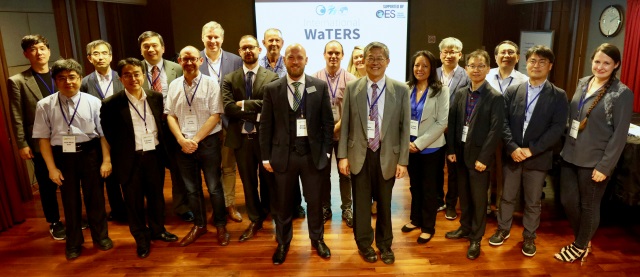
International WaTERS Workshop 2018 (credit NTOU)
Industry recognition: “and the award goes to…”
John Griffiths wins BSI International Standards Maker Award: John Griffiths, Associate of EMEC and former Technical and Compliance Director, won the coveted International Standards Maker Award at the BSI Standards Awards 2018. John was a principal force in the design and development of EMEC’s facilities in the early 2000’s and recognised the need for international standards for the nascent marine renewables industry. He has since been unswervingly committed to international cooperation, is a true ambassador for the standards community, and we can’t think of anyone more deserving of this award.
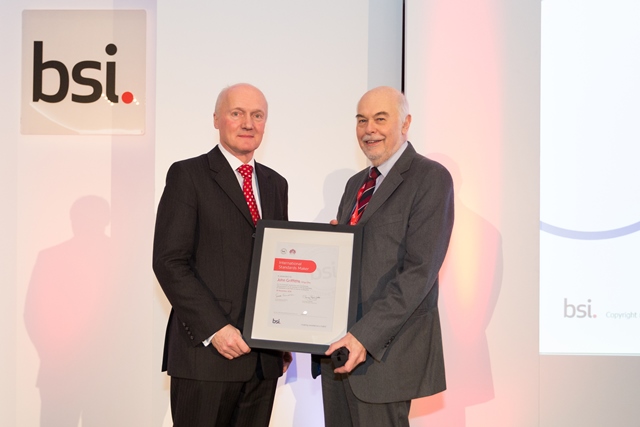
John Griffiths accepting BSI International Standards Maker Award (Credit BSI)
EMEC make ICE top 200 influencing world projects: To mark the Institution of Civil Engineers’ (ICE’s) 200th anniversary, and to support UK Government’s Year of Engineering, the Institution named EMEC as one of the 200 inspirational and world-changing projects from around the world throughout 2018 – what a commendation!
Marine energy shines at Scottish Renewables Green Energy Awards 2018: A number of our project partners were recognised at the SR Green Energy Awards, with the Surf ‘n’ Turf project being shortlisted for the Best Community Project award, and Microsoft’s Project Natick under water data centre project shortlisted for the Carbon Reduction award (just losing out to the V&A Dundee which opened earlier in the year and includes an exhibition on marine energy). Orbital Marine deservedly won the Best Innovation award for their SR2000 tidal turbine, and Leask Marine took home the Outstanding Service award, highlighting the calibre of Orkney’s marine energy businesses. Congratulations also to Nova Innovation for winning the Outstanding Project award. Overall, the awards truly showcased Scotland’s fabulous marine energy sector!
Movers and shakers at EMEC
Our team is expanding to support the growing number of projects as we continue our quest to develop a globally successful marine energy industry as we part of a clean energy system. We’ve welcomed 16 new members to the EMEC team this year, and with numerous internal job changes it can be hard to keep up with who’s who here at EMEC, so here’s the low down (see who’s who for details on the full EMEC team).
Operations & Technology team update:
- Susan Learmonth was promoted to Programme Officer from her previous role in the Support Team;
- Ray Banks, Chris Ward, Scott Crawford and Jerry Gibson were appointed to the ITEG project: Chris as Project Manager, Ray as Project Officer, Scott as Instrument and Controls Engineer, and Jerry as Operations Technician;
- Richard Ainsworth was appointed as Project Manager for several projects including HyDIME and MEA;
- Ruari Brooker was appointed as a Performance Test Engineer;
- Scarlette Lesma joined EMEC from Florida, as Project Officer with a focus on consents;
- Nick Wyatt, from New Zealand, joins us as Senior Electrical and Performance Test Engineer; and
- Dave Wakefield, who was previously in the position of ETV Manager, has moved into the role of Operations Technician.
We also had the pleasure of hosting three student interns this summer; Truce Jack, Michael De Bruin and Chris MacDonald, who have kindly shared their experience with us in the guest video blog: Low-down from EMEC summer interns
Commercial team update:
- Rob Flynn joins us from Ocean Energy Europe as our new International Development Manager, based in Cambridge;
- Jon Clipsham was promoted to Hydrogen Manager, with a new team in place to help deliver on hydrogen related projects; including Caron Oag as Hydrogen Marketing Officer and Sarah Jessen as Hydrogen Development Officer;
- Eileen Linklater will be returning to EMEC in the New Year to take on the role of External Relationship Manager.
Business Support team update:
- Molly Harris took on the new HR Officer role;
- Carly Banks joined as Project Administration Officer; and
- Karen Flett joined the support team as Finance Officer in December.
Final thoughts from Neil
Signing us off for the year, our Managing Director Neil Kermode would like to say a few words:
Looking back on my closing comments last year it is hard not to re-use them this year too: “2017 has been another remarkable year in a long line of remarkable years.” Well we seem to be keeping up that tradition as 2018 slots perfectly into that long line too.
I don’t think we could have hoped at the end of 2017 that within 12 months we would be able to show how marine renewables really works. 2018 saw Orbital Marine Power clearly show tidal energy supplying the community day after day, week after week. In effect one day per fortnight, for much of 2018, Orkney was running on tidal electricity. Amazing!
Having been at EMEC for over 13 years the temptation to say ‘we told you so’ is enormous. But beyond the smug satisfaction, this year proved that tidal energy works and can be depended upon demonstrating the possibilities for business that a de-carbonised energy supply system represents, and the value of innovation, particularly in rural and remote communities.
And of course, it is not just Orbital. All the other technology developers listed above have pushed their boundaries, demonstrated ‘learning by doing’ and can now see more of their development curves ahead of them. I am delighted to see how EMEC has helped those successes and we look forward to, many, many more.
2018 has also provided validation of the vision shown by the public sector in setting EMEC up as a means of fostering innovation. Nobody expected that, having signed up initially to enable wave energy, we would find ourselves hosting Microsoft’s underwater data centre and producing hydrogen for shipping from tides.
The diversity of activities that EMEC is now involved in illustrates perfectly what innovation is about. The key is to start and keep going, not to spend forever waiting for the right moment to commit. The decisions to form EMEC in 2003 created the environment that we now inhabit.
Our diversification into the production and supply of hydrogen has attracted enormous interest and has led to us breaking into using hydrogen for marine transport. This is a key part of delivering the Scottish Government’s Energy Strategy to see 50% of Scotland’s energy (not just electricity) delivered by renewables by 2030. That is a big ask, but we think we can see how to do it.
So where is this all going in 2019? Clearly the uncertainties over the UK’s relationship with the EU remains a worry, but the threats of unaddressed climate change are even bigger.
But, we now know we have some of the technology that can deliver a low carbon future whatever the political climate. We see that the coming months and years will provide enormous opportunities for EMEC, its suppliers and customers; provided the UK makes good on its promises to support innovation.
We are on a roll, we can point to success and we know what we need to do to get there.
Let’s get to it!
We wish you all a Merry Christmas, and look forward to an exciting 2019
